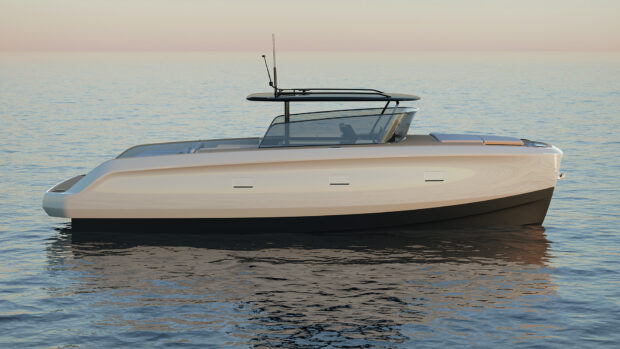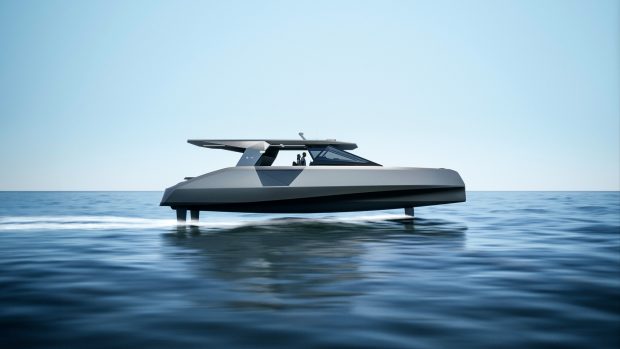Fitting foils to powerboats is all the rage, but how do they work and why is foiling back in fashion?
What is foiling?
Foiling refers to the use of hydrofoils attached to the hull of fast boats, which provides additional lift at planing speeds – often enough to lift the hull completely clear of the water.
What is the benefit of this?
Efficiency. The enemy of fast boats is the amount of effort required to push them through the water. Planing boats go some way to addressing this by rising up over their own bow wave and skimming across the surface, but the stern sections are still immersed, creating significant hydrodynamic drag. It follows that if you can lift the boat completely clear of the water, hydrodynamic drag is only acting on the foils themselves and the sterngear that propels and steers it.
Any advantages beyond efficiency?
Lifting the boat clear of the surface can reduce the disturbance of waves, smoothing the ride, but only up to a point. It’s not just about lift though – active foils can also be used to improve stability or handling and in some circumstances, can improve efficiency even without lifting the boat.
How do foils work?
Foils work in a similar way to aircraft wings. In simple terms, as they move through the water they deflect the flow, which exerts a force on the foil. If that force is upward, the faster they move, the greater the lift.
So why are they so much smaller than aircraft wings?
Because water is much denser than air – almost 800 times, in fact. The foils have far more to push against than aircraft wings, so don’t require the same surface area.

Is this new technology?
Far from it. Foiling technology can be traced back to 1898 when Italian inventor Enrico Forlanini began work on a ‘ladder’ foil system, obtaining patents in both the UK and the USA. He had a prototype operating on Lake Maggiore soon after. British boat designer John Thornycroft followed up with a series of scale models featuring stepped hulls and a single foil, and by 1909 had a full-scale 22ft prototype running. During WWII, the German military developed a 17-tonne foiling mine layer that was tested in the Baltic at speeds of up to 47 knots. By the early 1950s, the first commercial hydrofoil ferry was running between Italy and Switzerland and a decade later, a private hydrofoil yacht featured in the Bond movie Thunderball.
Why did they never catch on in production boating?
Traditionally, high-speed hydrofoils used large V-shaped foils that jutted out beyond the boat’s beam. This made berthing tricky and increased the draught. They were also costly to construct, vulnerable to damage and difficult to power, as the propellers of conventional shaftdrives would be clear of the water once foiling. Lastly, although hydrofoils were often more efficient than monohulls, high-speed cats could usually match the efficiency without the drawbacks.
Why are they back in the news?
Foiling technology came back into public focus when the 2013 America’s Cup contenders started to use foil-shaped daggerboards to hit speeds of more than 40 knots. Ben Ainslie’s spectacular last-gasp victory for the Oracle USA team and his subsequent BAR Land Rover Cup Challenger brought foiling to a global audience. More recently, we’ve seen the emergence of several foiling motor boats, including the SEAir RIB and the Sunreef Open 40 Power. More exciting still is the news that Princess will use an advanced Active Foil System on its new R Class superboat.
What has changed?
Technology has overcome many of the shortfalls of older systems. Simon Schofield, chief technology officer at BAR Technologies, told MBY the real game changer has been the adoption of ‘Dalí’ foils. Instead of two fixed V-shape foils, Dalí foils use four independent L-shaped blades that stick out of the hull at an angle before curving up like Salvador Dalí’s famous moustache. They are far more efficient and can be retracted, solving the berthing and draught issues. In addition, computer-controlled active systems allow the foils to be adjusted to suit speed and sea conditions.
This doesn’t just improve efficiency, it can enhance the ride and handling too. When cornering, for example, a traditional hydrofoil boat doesn’t lean into the turn, making it uncomfortable for passengers. An active system can adjust each foil to induce the correct degree of lean. Modern materials also reduce drag and cavitation.
How about propulsion?
The Enata Foiler uses twin BMW diesel 320hp engines, but instead of being connected to the propellers with hefty drag-inducing shafts and gearboxes, these generate electric power which can be sent down a thin flexible cable to slender electric motors mounted on the retractable rear foils.

Lifecord – The kill cord revolution
Lifecord, a new alarmed smart kill cord that knows when you are not wearing it, ensures you’ll never forget to

Motor boat stabilisers: DMS’s new stabilisation fins
DMS's new flapping fins could become a staple for motor boats

Hybrid heaven: Adler’s 76 Suprema
Taking diesel electric propulsion to a new level, Adler's 76 Suprema may just be too innovative for the yachting marketplace











